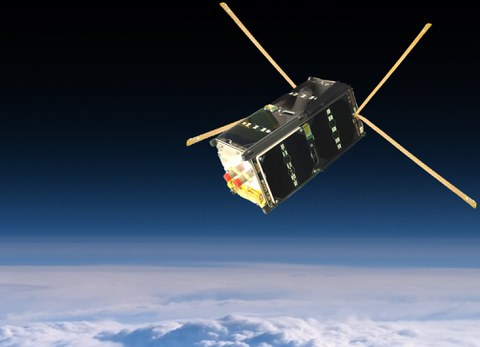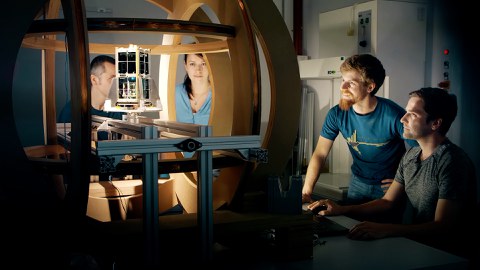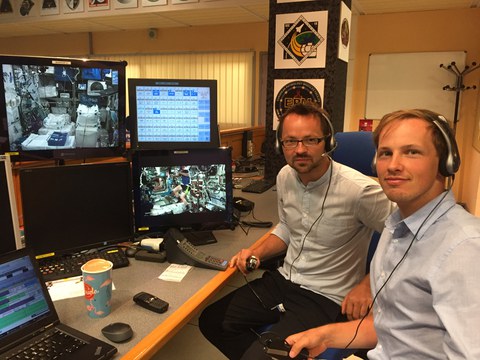Nov 26, 2024
Mission accomplished: Dresden nanosatellite burns up in the atmosphere

Nanosatellite SOMP2b in space
After a successful period of operation in space, TU Dresden's outpost has entered the Earth's atmosphere as planned and burned up. The SOMP2b nanosatellite was launched into space on a SpaceX Falcon 9 rocket in January 2021 and completed scientific and technological experiments that provided valuable data for space travel, materials and atmospheric research.

Students and staff during tests for attitude determination in space. SOMP2b uses sensors for the earth's magnetic field, the rotation rate and the sun
Dresden satellite sets new standards "TU Dresden's nanosatellite SOMP2b impressed with its innovative design, which allowed for more safety and more space for scientific experiments at the same time. The team's outstanding work is emphasised by the fact that the satellite was operational for longer than planned. The scientific results of the mission will make a significant contribution to enabling satellites to fly in very low Earth orbits in the future," explains Andres Bolte, Technical Coordinator for Small Satellite Technology at the German Space Agency at DLR.
Contribution to New Space With its compact size of just 20x10x10 cm3 and a mass of around 2 kg, SOMP2b impressively demonstrated the possibilities of functional integration. Its novel design, in which many important functions of a satellite were integrated into just one sidewall, enabled increased fault tolerance and more space for scientific experiments. "We have arranged such highly integrated sidewalls, which are the size of a slice of bread, four times to create the typical cuboid shape of a satellite," explains Dr. Tino Schmiel, Head of Satellite Systems and Space Sciences at the Institute of Aerospace Engineering. "If a component on one side panel fails, the function can then be taken over by the twin component on another side panel. In addition to the higher fault tolerance, this approach makes it possible to use inexpensive components from mass production instead of cost-intensive space-qualified components. This is particularly interesting for the NewSpace sector."
Research under extreme conditions Research is also possible: in its sun-synchronous orbit, SOMP2b collected measurement data on a daily basis, which is used for atmospheric research and materials development, among other things. The most important experiments included:
- Atmospheric research with FIPEXnano: this sensor measured the concentration of atomic oxygen in the higher thermosphere.
- Energy supply with thermoelectric generators: Uses natural temperature fluctuations to provide electrical energy. In contrast to solar cells, this also works in the Earth's shadow. Interesting for nanosatellites with a very small solar cell area.
- Materials research with CIREX: Innovative nanomaterials were tested here, including for radiation protection, which could find applications in space travel as well as in medical and automotive technology.

Dr. Tino Schmiel und Dipl.-Ing. Georg Langer an einer Bodenstation
Communication from orbit: a key to success The TU Dresden ground station played a central role in the SOMP2b mission. Dipl.-Ing. Georg Langer, who was responsible for satellite communication, was regularly able to contact the nanosatellite during its daily overflights over Dresden. Data was received and control commands transmitted up to twice a day. "Communication with SOMP2b enabled the team to precisely analyze the capabilities of the systems and react flexibly to challenges - a decisive factor for the success of the mission. ", explains Langer. The mission is not yet over for the team: The wealth of data is being analyzed and the knowledge gained is already being incorporated into the construction of the next satellite.
Contact:
Dr.-Ing. Tino Schmiel
Institute of Aerospace Engineering
Head of the Satellites and Space Sciences
Phone: 0351 463-38287
E-mail: tino.schmiel@tu-dresden.de
The project was funded by the German Space Agency within DLR e.V. and the Federal Ministry of Economics and Climate Protection on the basis of a decision by the German Bundestag: SOMP2 under the funding code 50RU1201, TEG within the funding project with the funding code 50RM1114 and CiREX within the funding project with the funding code 50YB1409. FIPEXnano was developed through various collaborations with industry, on behalf of the Mullard Space Science Laboratory, UCL/MSSL, and through educational projects at TU Dresden. FIPEXnano is partially funded by "The European Union's Seventh Framework Programme for Research and Technological Development under grant agreement no [284427].
